畅通工程续
现在,已知起点和终点,请你计算出要从起点到终点,最短需要行走多少距离。
Input
本题目包含多组数据,请处理到文件结束。
每组数据第一行包含两个正整数N和M(0<N<200,0<M<1000),分别代表现有城镇的数目和已修建的道路的数目。城镇分别以0~N-1编号。
接下来是M行道路信息。每一行有三个整数A,B,X(0<=A,B<N,A!=B,0<X<10000),表示城镇A和城镇B之间有一条长度为X的双向道路。
再接下一行有两个整数S,T(0<=S,T<N),分别代表起点和终点。
Output
对于每组数据,请在一行里输出最短需要行走的距离。如果不存在从S到T的路线,就输出-1.
明天就要讲图论了,之前虽然听过一遍,但是没有搞懂,感觉很难的样子。介于之前本人还写过两三道有关树,最小生成树,树状数组这类的题,晚上就先预习一下最短路径问题,先就着这一道题来系统的梳理一下Floyd把
Floyd:
动态转移方程 dist[i][j] = min(dist[i][j],dist[i][k] + dist[k][j]);
初始化//dist[i][j] 表示从i到j之间的最短距离
1 //dist[i][j] 表示从i到j之间的最短距离 2 int dist[maxn][maxn]; 3 for (int i = 0; i< n ;i++) 4 for (int j = 0 ;j< n ;j++) 5 dist[i][j] = edge[i][j];
时间复杂度 节点个数 N,边个数 M O(N3)
• 求所有节点到节点 1 的最短距离
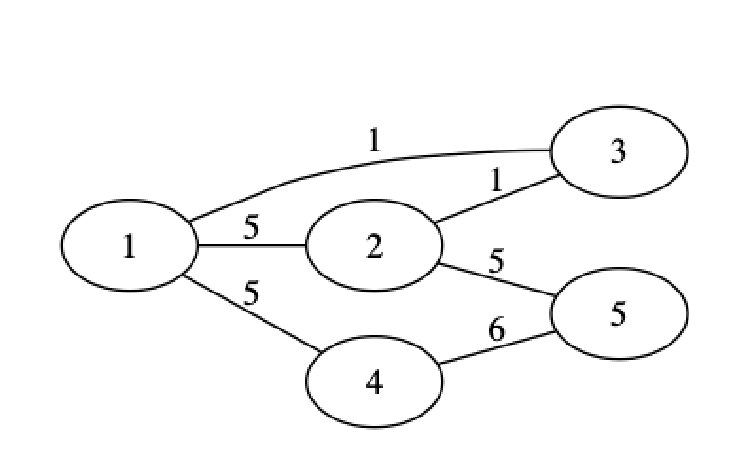
1. 初始化
• dist 矩阵 – dist[i][j] 表示节点 i 到节点 j 之间的最短路径长度 – dist 初始化为 edge

2. 流程
(a) step 1 • 通过节点 1 作为中转节点更新 dist • 更新公式 dist[i][j] = min(dist[i][1] + dist[1][j],dist[i][j]);
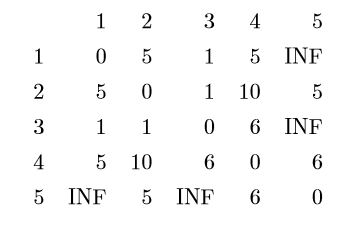
(b) step 2 • 通过节点 2 作为中转节点更新 dist • 更新公式 dist[i][j] = min(dist[i][2] + dist[2][j],dist[i][j]);
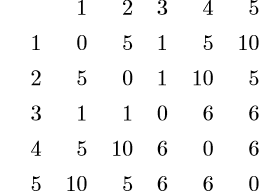
(c) step 3 • 通过节点 3 作为中转节点更新 dist • 更新公式 dist[i][j] = min(dist[i][3] + dist[3][j],dist[i][j]);

(d) step 4 • 通过节点 4 作为中转节点更新 dist • 更新公式 dist[i][j] = min(dist[i][4] + dist[4][j],dist[i][j]);
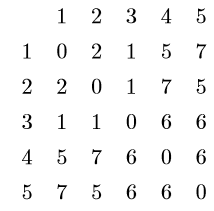
(e) step 5 • 通过节点 5 作为中转节点更新 dist • 更新公式 dist[i][j] = min(dist[i][5] + dist[5][j],dist[i][j]);
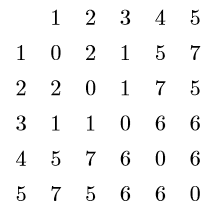
有一说一,这道题显然代码为:
1 #include <iostream> 2 #include <cstdio> 3 #include <cmath> 4 #include <cstring> 5 #include <algorithm> 6 using namespace std; 7 int const maxn=1000; 8 int const INF=1e9; 9 int dist[maxn][maxn]; 10 int n,m; 11 int floyd(int s,int t){ 12 for(int t = 0;t < n;t++) 13 for(int i = 0;i < n;i++) 14 for(int j = 0;j < n;j++) 15 if(dist[i][j] > dist[i][t] + dist[t][j]) 16 dist[i][j] = dist[i][t] + dist[t][j]; 17 if(dist[s][t] == INF) 18 return -1; 19 else 20 return dist[s][t]; 21 } 22 int main(){ 23 int a,b,x,s,t,ans; 24 while(scanf("%d %d",&n,&m) != EOF) { 25 for(int i = 0;i < n;i++) 26 for(int j = 0;j < n;j++) 27 dist[i][j] = (i == j ? 0 : INF); 28 while(m--) 29 { 30 scanf("%d %d %d",&a,&b,&x); 31 if(x < dist[a][b]) 32 dist[a][b] = dist[b][a] = x; 33 } 34 scanf("%d %d",&s,&t); 35 ans = floyd(s,t); 36 printf("%d\n",ans); 37 } 38 return 0; 39 }